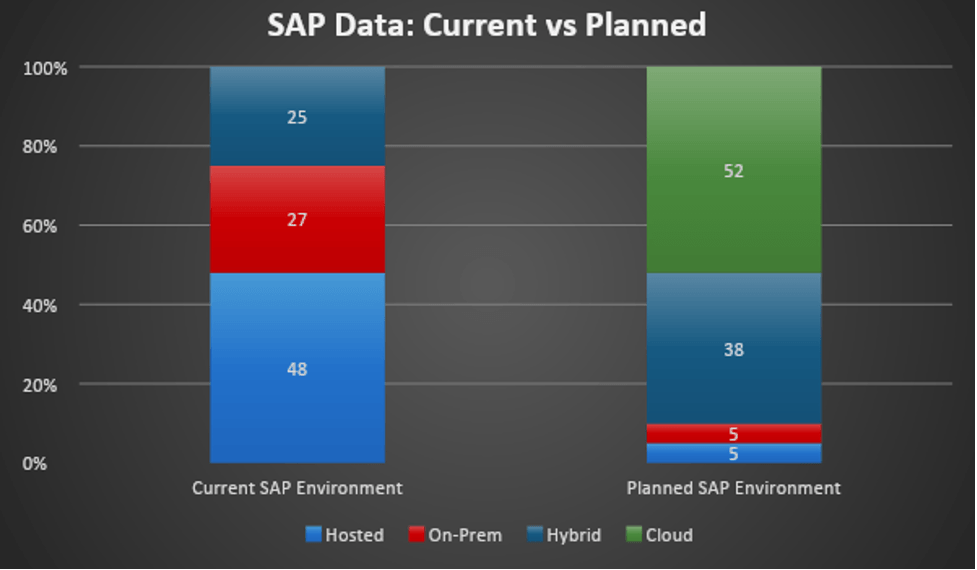At the end of March 2021, American Digital conducted an inclusive survey of the state of migration to SAP HANA. These findings are based on surveys, questionnaires, and interviews with SAP customers across many industries. These statistics were taken from the Director and Manager level within IT organizations. The people who are responsible for crafting organizational strategy as well as implementing it. They are the ones close enough to the situation to provide valuable insight and a truthful perspective.
A big topic of conversation has been the SAP journey. Today, most organizations see that as a journey to HANA or S/4HANA. That journey also typically entails a cloud component. Almost every organization participating has asked the how, where, and why they should take the next step on their SAP journey. But how many have begun?
Based on our findings, 70% of SAP customers surveyed have begun the migration process to SAP HANA. That is a pretty significant and promising number. It should be noted that we asked about HANA, the database, and the foundation for future SAP technology. We did not ask about S/4HANA, which is a more significant transformation of business process, application, technology, etc.
Have you begun the migration process to SAP HANA?
Yes 70%
No 30%
I mentioned cloud in the same breath as the SAP journey. These are not automatically related or mutually exclusive. You can have one without the other. Realistically organizations are taking an SAP journey opportunity to evaluate other associated technologies. It’s a perfectly logical time to look at your hardware/infrastructure/hosting provider/etc. at the same time, you evaluate a move in SAP technology. Therefore, it’s important to understand where organizations are currently vs. where they plan to go.
By asking the question
Pre-migration, where does your organization host your data?
yielded the following results:
Hosted 48%
On-prem 27%
Hybrid 25%
Cloud 0%
This breakdown is a traditional way to think about infrastructure over the last decade; most organizations looked to save costs by outsourcing to a hosting provider. Hence seeing half of the organizations with a hosted SAP environment was not surprising. What was surprising was not seeing any organization surveyed hosting their SAP environment entirely in the cloud. That’s the opposite of what you might hear from the cloud companies. But if you understand the industry, you’re probably not surprised by this either. When organizations make a move to the cloud, most do so in a hybrid model. Illustrated by 25% of organizations currently running their SAP environment as a hybrid, meaning some SAP workloads are in the cloud, some are elsewhere.
Now is a perfect point to define what cloud means in this article’s context. It will be essential to understand when we look at where organizations are going with their SAP environments. Here cloud is defined as both public and private cloud. Cloud is any hosting platform you, the customer are not responsible for managing. Examples of this are AWS, Azure, GCP, Rackspace, HPE GreenLake, American Digital’s Private Cloud, and even SAP’S HEC. There are dozens of others out there too. Just don’t get caught assuming cloud had to mean one of the three hyperscalers.
So, where does your organization plan to host your data once you’ve completed your migration to SAP HANA?
Cloud 52%
Hybrid 38%
On-prem 5%
Hosted 5%
A whopping 90% of companies plan to take advantage of the cloud, in one form or another. Fifty-Two percent plan to completely outsource their SAP environments to a private or public cloud provider or multiple cloud providers. Another Thirty-Eight percent plan to run a hybrid model of some workloads in the cloud and some not.
A few deductions can be made, such as the cloud footprint will continue to grow within organizations and that more and more SAP workloads will eventually reside in a cloud solution. But one should also note that everything will not be running in the cloud. There’s also no one-size-fits-all model or SAP migration path that works for every organization in every situation.
Now, let us look at that migration path and understand which phases organizations are currently in. When asked which phase of your HANA migration process is your organization currently in, the results yielded a vast array. Some organizations have finished their migration, while others are just beginning their investigation and road-mapping.
Post-migration 41%
Currently migrating 33%
Investigation and planning phase 19%
No known plan to migrate in the near future 7%
Interesting to see seven percent having no plans to migrate to HANA. I think this would be worth diving into further to understand why. Anecdotally I’ve heard reasons like “we don’t believe SAP will stick to their current 2027 deadline” or “as the 2021 deadline approaches, we’ll use that opportunity to re-evaluate ERP platforms.” However, I don’t have any hard data to back these up at this point.
Another point I found rather interesting is that Forty-One percent of respondents said they’re in the post-migration phase. Comparing this with data I’ve seen elsewhere from SAP and ASUG, our 41% seems a bit high for SAP environments running HANA. Several factors could have attributed to that, but also, there has been a rapid acceleration of organizations adopting and moving to HANA. I know the American Digital team has had our hands full with HANA migrations over the past few months. Not just from a migration perspective but even more so from helping organizations roadmap their HANA journey. I see today as the precipice of rapid adoption of HANA over the next year or two. Only time and next year’s survey will tell.



